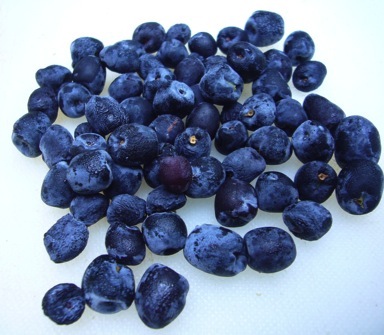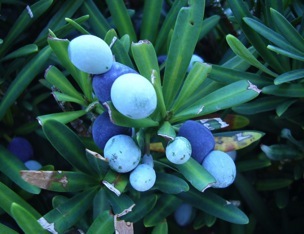Podocarpus: Your Own Hedge Fund
One can’t learn everything at once, and so I came to know the Podocarpus macrophyllus late in my foraging career.
There were very good reasons for this. A similar looking shrub planted locally has toxic fruit, and parts of the Podocarpus are toxic as well save for the aril. So it was one of those plants I knew about but put off for another day. And I did until a foraging friend, Marabou, got me interested in them again.
Like so many other things on the Internet that starts out as a “warning” on one site becomes “avoid” on another, “toxic” on a third and “deadly” by the fourth. It is truly unfortunate that every new medium of communication invented by man becomes a heap of nonsense. Most sites will tell you the fruits of the Podocarpus macrophyllus are toxic and avoid them. This is highly inaccurate. The plant and seed are toxic. The seed’s aril or “receptacle” is edible. That aril can ripen to red, blue or dark purple. The point is the fleshy aril pulp is edible raw or cooked. The seed is not edible. I also think that if one is going to eat a lot of them one also should not eat the core found in the aril. I suspect that in ripe fruit the core (stem) through the aril is the source of occasional reports of toxicity, particularly among children who eat a lot of them.
Podocarpus (pod-oh-KAR-pus) means “foot fruit” and macrophyllus (mak-roh-FIL-us) big leaved. The “foot fruit” is very similar to how cashews grow, seed on one end, fruit on the other. (Raw cashews by the way are toxic.) The strap-shaped leaves are skinny, and while much longer than wide, they are not greatly long, up to 3 inches. The tree is native to southern Japan and China. In Japan it is called Kusamaki or Inumaki. In China it is called Luo han song. It has at least eight names in English, best not used. Kusamaki can mean “grass plant” in Japanese, a reference perhaps to the leaves.
There are about 100 species in the genus, give or take a half dozen either way. The P. macrophyllus was introduced to the United States in the 1800s, probably before 1860, and no doubt no later than the Japanese Centennial exhibit in 1876 in which kudzu made its debut as well. In its native wild P. macrophyllus can grow to an 80-foot tree. Locally it is a landscape standard and escaped opportunist (it grows quickly from seed.) On a bike trail nearby there are two 40-foot Podocarpus trees. The P. macrophyllus with red fruit is usually the variation Maki.
While many authors say the fruity part is flavorless and slimy, I have found them to be sweet and juicy. They taste very much like blueberries to me, or perhaps red grapes minus the tartness though the texture is similar. But, not all palates agree. Locally they ripen around the end of July and the beginning of August, some years mid-August. Fruit left on the bush to dry have a texture similar to raisins with a hint of pine. Interestingly, the P. macrophyllus is related to the Nagi Tree which has an inedible blue fruit. The seed oil of the Nagi Tree is edible but not the seed itself or its covering.
Since the P. macrophyllum seed is not edible and must be separate from the aril, I have found the quickest and easiest way to do that is to twist the two parts apart, rolling one part one way, and the other part the other way. Keep the aril and throw away the seed. The wood is used in making furniture, paper, and farm tools
Green Deane’s “Itemized” Plant Profile
IDENTIFICATION: Erect, slim, evergreen shrub or tree with dark glossy green leaves with lighter underside. Two to four inches long, a quarter inch wide, tapering to a point, no veins except for prominent midrib. Attached in dense spirals. Fruit two parts, a fleshy receptacle then seed. Seed has blue sheen that rubs off to reveal a green seed. Receptacle can be blue to purple to red. Edible. The attached seed is NOT edible.
TIME OF YEAR: Fruits in summer, locally late July into August
ENVIRONMENT: Well-drained soil, but usually is found in landscaping. An extremely common hedge plant, found across the southern United States and up the west coast.
METHOD OF PREPARATION: Arils raw or cooked. Can be made into jelly, pies and the like. Seeds are not edible.



